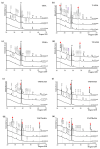Evaluation of the Cathodic Electrodeposition Effectiveness of the Hydroxyapatite Layer Used in Surface Modification of Ti6Al4V-Based Biomaterials
- PMID: 36234265
- PMCID: PMC9572782
- DOI: 10.3390/ma15196925
Evaluation of the Cathodic Electrodeposition Effectiveness of the Hydroxyapatite Layer Used in Surface Modification of Ti6Al4V-Based Biomaterials
Abstract
The important issue associated with the design and the fabrication of the titanium and titanium alloy implants is the increase of their biointegration with bone tissue. In the presented paper, the research results concerning the conditions used in the cathodic deposition of hydroxyapatite on the surface Ti6Al4V substrates primarily modified by the production of TiO2 nanoporous coatings, TiO2 nanofibers, and titanate coatings, are discussed. Despite excellent biocompatibility with natural bone tissue of materials based on hydroxyapatite (HA), their poor adhesion to the substrate caused the limited use in the implants' construction. In our works, we have focused on the comparison of the structure, physicochemical, and mechanical properties of coating systems produced at different conditions. For this purpose, scanning electron microscopy images, chemical composition, X-ray diffraction patterns, infrared spectroscopy, wettability, and mechanical properties are analyzed. Our investigations proved that the intermediate titanium oxide coatings presence significantly increases the adhesion between the hydroxyapatite layer and the Ti6Al4V substrate, thus solving the temporary delamination problems of the HA layer.
Keywords: Ti6Al4V alloy; cathodic electrodeposition; hydroxyapatite; nanomechanical properties; surface modification.
Conflict of interest statement
The authors declare no conflict of interest. The funders had no role in the design of the study; in the collection, analyses, or interpretation of data; in the writing of the manuscript; or in the decision to publish the results.
Figures







Similar articles
-
TiO2/HA and Titanate/HA Double-Layer Coatings on Ti6Al4V Surface and Their Influence on In Vitro Cell Growth and Osteogenic Potential.J Funct Biomater. 2022 Dec 1;13(4):271. doi: 10.3390/jfb13040271. J Funct Biomater. 2022. PMID: 36547531 Free PMC article.
-
Titania Nanotubes/Hydroxyapatite Nanocomposites Produced with the Use of the Atomic Layer Deposition Technique: Estimation of Bioactivity and Nanomechanical Properties.Nanomaterials (Basel). 2019 Jan 19;9(1):123. doi: 10.3390/nano9010123. Nanomaterials (Basel). 2019. PMID: 30669454 Free PMC article.
-
Assessment of Titanate Nanolayers in Terms of Their Physicochemical and Biological Properties.Materials (Basel). 2021 Feb 8;14(4):806. doi: 10.3390/ma14040806. Materials (Basel). 2021. PMID: 33567667 Free PMC article.
-
Surface Activation and Pretreatments for Biocompatible Metals and Alloys Used in Biomedical Applications.Int J Biomater. 2019 Jun 2;2019:3806504. doi: 10.1155/2019/3806504. eCollection 2019. Int J Biomater. 2019. PMID: 31275394 Free PMC article. Review.
-
Advances in the surface modification techniques of bone-related implants for last 10 years.Regen Biomater. 2014 Nov;1(1):67-79. doi: 10.1093/rb/rbu007. Epub 2014 Oct 20. Regen Biomater. 2014. PMID: 26816626 Free PMC article. Review.
Cited by
-
Materials Make a Better Life: Functional Metals, Metal Oxides, and Metal Complexes.Materials (Basel). 2023 Feb 24;16(5):1899. doi: 10.3390/ma16051899. Materials (Basel). 2023. PMID: 36903012 Free PMC article.
-
TiO2/HA and Titanate/HA Double-Layer Coatings on Ti6Al4V Surface and Their Influence on In Vitro Cell Growth and Osteogenic Potential.J Funct Biomater. 2022 Dec 1;13(4):271. doi: 10.3390/jfb13040271. J Funct Biomater. 2022. PMID: 36547531 Free PMC article.
References
-
- Geetha M., Singh A.K., Asokamani R., Gogia A.K. Ti Based Biomaterials, the Ultimate Choice for Orthopaedic Implants—A Review. Prog. Mater. Sci. 2009;54:397–425. doi: 10.1016/j.pmatsci.2008.06.004. - DOI
-
- Attar H., Löber L., Funk A., Calin M., Zhang L.C., Prashanth K.G., Scudino S., Zhang Y.S., Eckert J. Mechanical Behavior of Porous Commercially Pure Ti and Ti–TiB Composite Materials Manufactured by Selective Laser Melting. Mater. Sci. Eng. A. 2015;625:350–356. doi: 10.1016/j.msea.2014.12.036. - DOI
-
- Gain A.K., Zhang L., Quadir M.Z. Composites Matching the Properties of Human Cortical Bones: The Design of Porous Titanium-Zirconia (Ti-ZrO2) Nanocomposites Using Polymethyl Methacrylate Powders. Mater. Sci. Eng. A. 2016;662:258–267. doi: 10.1016/j.msea.2016.03.066. - DOI
-
- Liu S., Shin Y. Additive Manufacturing of Ti6Al4V Alloy: A Review. Mater. Des. 2018;164:107552. doi: 10.1016/j.matdes.2018.107552. - DOI
-
- Gain A.K., Zhang L., Lim S. Tribological Behavior of Ti–6Al–4V Alloy: Subsurface Structure, Damage Mechanism and Mechanical Properties. Wear. 2021;464–465:203551. doi: 10.1016/j.wear.2020.203551. - DOI
LinkOut - more resources
Full Text Sources

